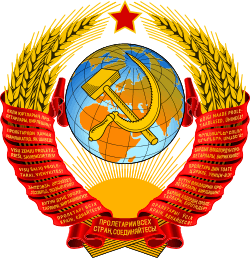State Defense Committee
The State Defense Committee (Russian: Государственный комитет обороны, ГКО, Gosudarstvennyj komitet oborony, GKO) was an extraordinary organ of state power in the USSR during the German-Soviet War (Great Patriotic War) which held complete state power in the country.
General scope
GKO was created on June 30, 1941, a week after the invasion of the Soviet Union by the Nazi Germany and by a compound decision of the Presidium of Supreme Soviet of USSR, Council of People's Commissars of USSR, and the Central Committee of the Communist Party of the Soviet Union. The necessity of creation of the organ were motivated by a complicated situation at the front-lines that required more dictatorial form of government (centralized to a maximum degree). The Supreme Soviet of USSR, however, was not suspended and on June 18, 1942 in Moscow took place the 9th session of the state government body that consisted of over a thousand of people's deputies.[1]
On June 29 and 30 Stalin, according to several historical records, was in a "depressed state" and moved to the Kuntsevo Dacha (or Near Cottage-estate). Vyacheslav Molotov (Narkom of Foreign Affairs) called for a meeting in his cabinet Lavrenty Beria (Narkom of Internal Affairs), Klim Voroshilov (Deputy-Chairman of Sovnarkom), Georgy Malenkov (member of Sovnarkom bureau), all of whom later also were joined by Anastas Mikoyan (Narkom of Foreign Trade) and Nikolai Voznesensky (First Deputy-Chairman of Sovnarkom). It was decided to place Stalin as the head of the committee, due to his authority in the country. In the afternoon all six of them drove to Stalin's cottage-estate for Stalin to accept his functions as the head of state and divide duties in the newly created committee.
Composition
The initial composition of the committee was such:
- Chairman - Stalin
- Deputy Chairman - Molotov (until May 16, 1944)
- other members - Beria, Voroshilov, Malenkov (Aviation Industry)[2]
On February 3, 1942 the members of the committee also became the chairman of Gosplan Voznesensky and Mikoyan, while on February 20, 1942 was also included Lazar Kaganovich (Narkom of Transportation). By the end of the war on November 22, 1944 Nikolai Bulganin (Chairman of State Bank Directory) replaced Klim Voroshilov in the committee.
See also
References
- ↑ Handbook on the History of the Communist Party of the Soviet Union
- ↑ Handbook on the History of the Communist Party of the Soviet Union
Bibliography
- Barber, John, and Harrison, Mark. (1991). The Soviet Home Front 1941–1945: A Social and Economic History of the USSR in World War II. London: Longman. ISBN 0-582-00964-2, ISBN 0-582-00965-0.
- Werth, Alexander. (1964). Russia at War 1941–1945. New York: Carrol and Graf.
| Wikisource has original text related to this article: |
Further reading
Glantz, David M. When Titans Clashed: How the Red Army stopped Hitler. Lawrence, KS: University Press of Kansas, 1995. ISBN 978-0-7006-0899-7 Overview of Eastern Front from Soviet side.
Roberts, Geoffrey. Stalin's Wars: From World War to Cold War, 1939-1953. New Haven, CT: Yale University Press, 2006. ISBN 0-300-11204-1 Post-revisionist study of Stalin's wartime and post-war leadership.
